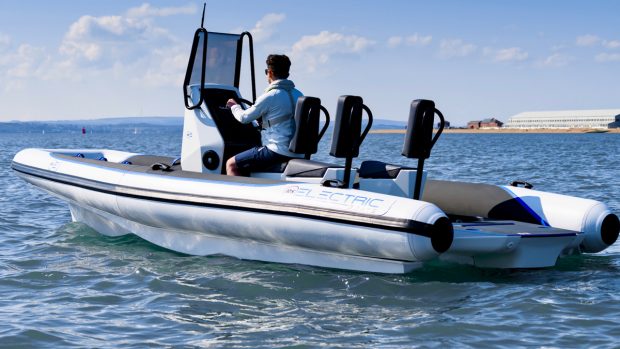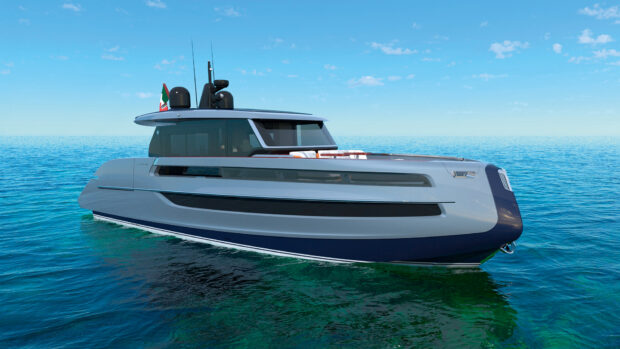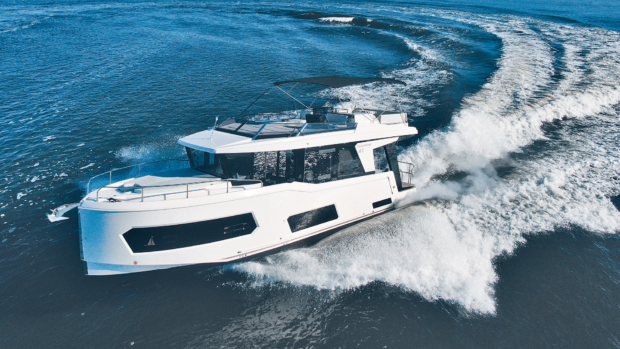It's been a busy couple of weeks for the crew of Egret, who have taken to the Tongan lifestyle
Position: S15 56.28 W173 46.07, Niuatoputapu Island anchorage (New Potatoes), Kingdom of Tonga
Scott (YT) and Mary Flanders (MS) left Gibraltar on 16 September 2006, and we’ll be following their journey every step of the way, thanks to this unique online “blog”. For a complete list of all the couple’s blog entries click here
It’s been a busy couple of weeks for the crew ofEgret, who have taken to the Tongan lifestyle
Note: We have crossed the International Date Line and we have gained an additional day by skipping one entirely. N55New Paige’sanniversary was on August 26 and they literally missed the date as they crossed from American Samoa to New Potatoes (they left on the 25th, spent one day at sea, and arrived on the 27th)
Saturday 30 August
Well, mis amigos,Egrethas arrived in the Kingdom of Tonga. First however, let us regress back to American Samoa. After clearing the harbour in American Samoa to begin our journey to Tonga we ran the engine up to 1800RPM to clean debris off the prop. No sooner did we do this that we had a 5-degree increase in engine temperature. I thought perhaps our keel cooler had become as fouled as our chain with slimy grass. However, once we had reached New Potatoes I dived under using our hookah rig, (electric air compressor and regulator) and found it to be quite a different story. The prop was extremely fouled, and we had a number of first time barnacles on the aft third of the bottom. The keel cooler was fouled but not to the point of disaster. It took a full two hours of working on the bottom to clear up the mess. We still have an hour’s work to do to get back to an optimum bottom.
In retrospect I would rather have spent a fast-paced week in American Samoa shopping and touring around, rather than the two weeks we have just spent. In hindsight I would also have started the mains each day, given the prop a spin in forward and then reversed while on anchor (and bow thruster). I think this would have eliminated the fouling on our bottom and chain fouling, as well as the slimly, stinky, watermaker filter replacement. In the end we either had to make water at high tide or take on some suspect dock water. N55New Paigesuffered the same fouling issues and they also burned 25% more fuel than normal. They’re cleaning the bottom of their boat today (it’s raining and we are all pottering).
We left American Samoa in daylight, just before dark, so we arrived in New Potatoes sooner than we would have liked. Eight miles out we jogged offshore (we turned around and headed slowly up sea at 975RPM) for an hour and fifteen minutes then turned around on our original heading at 1050RPM, the lowest setting where the stabilisers are still efficient.
As we approached the Kingdom of Tonga the first thing we saw was the conical shaped island of Tafahi. Tafahi has 81 residents and no harbour, just a leeward shore anchorage.
We trolled baits up and down on the windward side of New Potatoes (with no luck) before entering the harbour. In the distance we saw the spouts of a few of the large number of whales wintering in Tonga, while dolphins escorted us in. These were the first dolphins we had seen since Chile. The harbour, like so many others we have come across, requires patience as you wait until the pass opens up visually. When lined up the pass is straightforward, although it’s a bit shallow in spots (10ft or so). The markers are excellent and there are simple to use range markers on the beach.
TK (our anchor) splashed down in 26ft of opaque water and held on the first set. Shortly after anchoring our buddies onGrace, the South African sailing catamaran, and N55New Paigearrived as well. All together there were 13 boats in the harbour.
As we entered a few other boats had to clear in as well so we waited while the four Tongan officials (customs, health, agriculture/plant quarantine and one other…police?) made the rounds, being deposited by the last boat visited.
They were quite friendly and we later paid a total of about $50 in the main village, 3km up the road. The agriculture agent was concerned about our fresh fruit and veggies, but in the end he let us keep them with a promise we wouldn’t bring them ashore. Once ashore we changed our Pesos for Tongan Paanga (unit of currency – about 175p to $1).
On our first night here we were all invited to join a local fundraising event for a Catholic Sunday school. This was the second real South Pacific event that we have attended (the first was Bastille Day in Bora Bora). The singing during prayer was a most beautiful. NP Roger and I were sitting with locals drinking kava at the time and the kava club could really sing.
Kava is a slightly bitter, lip numbing, mildly narcotic drink that the locals drink by the gallon. Kava is served in half of a coconut shell that is passed around – you drink the shell then pass it back to the bowl guy. There were about 10 or so of us and the different shells were kept busy, from time to time a local waiter would come by with a 20lt pail of fresh kava to refill BG’s wooden bowl and keep things going. The women didn’t drink the kava. At the head of our group was the local entrepreneur who has a machine that grinds the kava root to make the brew. In the old days the women chewed the root and spat the pulp into a bowl. Not my kind of deal.
While we drank the kids danced to loud rock music. Their skin was covered in a clear shiny paste that allowed money to stick to it when it was pressed into the shiny spots. They wore costumes and danced traditional dances. The kids were divided into age groups, starting at 3-5 years olds. Suitably, the youngest ones got the most money – some of them were totally covered with money from the waist up. The locals gave as freely as we did; they are very generous for those that have little.
The next night we went to dinner at a different type of place. We arrived at high tide for dinner at a resort on a small leased island. To reach it we had to swim/wade across a 200yd-wide channel – and for those of us that didn’t want to get wet a man met us with a small dink. With dry clothes and backpacks stowed away he pulled the dink across while the kids and some very wet adults made the watery trek.
Laura, the resort keeper, met us on the other side and ushered us in to the dining room. The view across to the perfect conical island was stunning. The dining room/kitchen building was square with a small kitchen and head. The menu consisted of fresh fish or frozen steak and we had a great night. After counting beer cans and taking what seemed like a wild stab at accounting Laura presented us with a very reasonable bill. We paid and waded back across the channel at low tide.
It is a fun resort with modern cottages furnished with materials from New Zealand. Rooms are spotless and the bathrooms have modern fixtures. For those that like out of the way places Palm Tree Island Resort is a treat. Laura is a great hostess and a good friend to the yachties. A good off the beaten path three-stop trip would be: Robinson Crusoe Island – Juan de Fernandez Islands Group (Chile), Easter Island, and here in New Potatoes.
Fishy tales
Yesterday we took three locals out fishing aboardEgretalong withNew Paige’sRoger and his daughter Kimberly. Our Tongan guests told us about a sea mount where the local fishermen go for tuna.
We started late (7am, the fishermen leave at 4am in their little outboards) but we still found the tuna birds, just south of the seamount, and hooked a tuna (‘tuna birds’ are a dead giveaway for finding tuna). Locals fish with hand lines and homemade lures, not two speed reels and roller bearing rods, like us. Our Tongan guests on board freaked out when the first fish ate and was pulling drag they couldn’t stop from going out. I could tell by the reel sound that it wasn’t a big fish so I kept it going. This freaked them out even more and they started shouting “fish on”, or something like that. I kept going until we hooked a second fish and then I slowed down. We caught two small yellowfin tuna, of 8 and 12lbs.
Once I’d reeled them in I grabbed them by the tail and cut the bloodline just behind the pectoral fins to bleed. I asked our Tongan friends to cut the gills out and learned something new myself. Their hands were so strong they just ripped the gills out by hand and pulled out the guts in one attached piece as well. Once underway I filleted them but this drew strange looks from the locals who wanted to save the heads and carcases as well. They eat everything – including the eyeballs, they waste nothing.
We headed back with Mary running the boat and Kimberly looking for birds with the binoculars. We were lucky on the way back to hook a nice mahi mahi (dolphin fish) the girls found under a couple diving birds. One of the locals was struggling with the fish, as it turned sideways foul-hooked. We did our usual running the boat in increasingly tighter circles trick to bring the fish to the boat. When it was close I saw a second fish down deep. I raced down to the cockpit from the flybridge and put out another bait. Knowing the drill, Mary hit the throttle and immediately we hooked the second fish. The first was a large cow (girl fish) and the second was a larger bull (boy fish).New PaigeRoger was on the boy fish rod and had a tough time of it when his rod seat broke away from the fibreglass rod itself. At one point Roger was cranking furiously, with one local holding the reel in place and another stopping the rod from twisting. The bull was well over 30lbs and Roger’s heaviest mahi mahi ever.
Once we had re-anchored,New PaigeJoan towed backEgret’sdinghy and took the locals to shore. We gave them the tuna and the heads from both mahi mahi. The two mahi mahi will be served at a picnic for yachties hosted by the Department of Ministry at a small local island behind the anchorage.
The simple life
Last night we went to the home of Sea-ah, a government employee. Her husband, Niko, works 3-4 months a year in New Zealand. They are well off by local standards with an old Toyota van. They live in a chain-link fence compound with five houses of family members. The houses (approximately 15ft x 20ft) are made from corrugated tin and very old planks of wood. The house corners are made round by bending tin around a coconut tree. They have a large central water cistern filled by rain running off a roof and at night they fire up a generator to light a single long fluorescent light. We had a great evening mixing with the yachties and locals. I’m sure they can’t begin to comprehend how we live in such relative luxury and it certainly makes us feel guilty.
I read a story written in a magazine describing the inhabitants of a Caribbean island, who the writer felt held back a veneer of resentment for the yachties. Here we don’t get the slightest feeling along those lines. Locals seem to be happy with their lives and it shows.
A young couple have just come visiting to get some advice on cruising in Chile and the Chilean Channels. We dug out the guides, charts and showed them pictures on the laptop. It was a real trip down memory lane for us. M
Sunday 31 August
Today was spent reading and pottering around the boat in the rain. Sundays in the South Pacific islands tend to be family days. We are currently sorting though more photos – it is hard to believe our trek from Gibraltar to New Zealand is within a month of being completed. It seems like ages ago that we set off, but then in other ways, just like yesterday. You can’t possibly imagine what we have seen and experienced along the way except from what few words and pictures we have sent through these updates. I’m getting ahead of myself so we’ll leave this alone for another couple months. Once in New Zealand and settled we’ll put our thoughts in print.
Don’t think New Zealand is the end ofEgret’sadventures. We are just getting started and we plan to do this for a long time. If we totter off the dock pushing our walker and don’t make it, what the hell? It sure beats tubes and bedpans and drooling and the sadness of it all.
Monday 1 September
This afternoon we attended a ‘feast’ put on by local officials for the yachties, held on a small offshore island. There were palm fronds cut and used as mats to sit on while eating and the locals roasted two small pigs and cooked the rest of the food in an underground umu. (native oven). The umu is a shallow pit dug in the sand with coals as the first layer, then small rocks to retain the heat, a layer of a large starchy root, covered by tapioca root, covered withEgret’smahi mahi, wrapped in tin foil with coconut milk and spices. On top of this were coconut husks and large leaves (they normally use banana leaves but there are none on the island), then a sack material, then dirt with hot coals on top, covered by more dirt and then the whole thing covered with palm fronds.
The food had been cooking since early morning and we had seven dinks full of yachties to enjoy the event, along with six or seven Tongan adults and a few kids. The locals chopped coconuts and added a straw to provide drinks.
The locals waited until we had finished eating until they feasted. There is no question how these folks get so large by looking at the portions of starchy root, tapioca and meat they ate. One local gave a speech and told the crowd that the money for the feast came out of our clearance duties and they wanted nothing from us. It was their way of showing how pleased they were for us to visit their island and help with their economy.
If someday you cruise the South Pacific in your own little white fibreglass boat, be sure and make New Potatoes your first stop in Tonga before heading south to the rest of the chain.
This afternoon we sent OMNI Bob an email saying we would like to leave in a couple days, sailing south to the Tongan Vava’u Group of islands (Vav ow). Unfortunately it is time to move on, however OMNI Bob’s forecast is particularly important for this overnighter as there is serious weather south and east of us with big seas and a lot of wind.
There is so much to see in the rest of the Tongan chain before we start to cross to New Zealand in mid October at the first weather opportunity.
Picture 1. Local Tongan girl dancing for charity.
Picture 2.New Paige’sRoger, Kimberly and three local Tongans with two nice mahi mahi.









